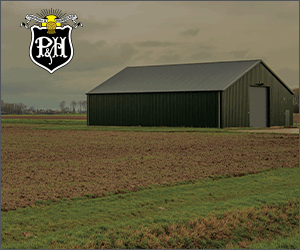Taking on a challenge
SO FAR SO GOOD FOR SOYBEAN AND SPRING WHEAT CHALLENGE PARTICIPANTS
eyes are on the prize as farmers across the province are diligently managing their crops in hopes to be the big winner in Grain Farmers of Ontario’s Soybean Yield Challenge and Spring Wheat Challenge.
“We’re just watching it grow at this point,” says John Nanne, a farmer from Pakenham. Nanne, who farms with his wife Beth and five children, is an entrant in the inaugural year of the Spring Wheat Challenge.
finding the winning strategy
Nanne got his wheat in the ground early this spring and planted his 85 acres on April 5 and 6 at 145 pounds of seed per acre.
In addition to his 85 acres of spring wheat, Nanne also farms soybeans, corn, hay and mixed grain along with a 45 cow dairy operation. The field entered in the challenge is planted with Sable, a C&M Seeds variety.
The Spring Wheat Challenge is open to all Ontario farmers. The competing field must be a minimum of 10 acres and the harvested plot must be at least 1.5 acres of that same field. Any certified spring wheat variety is eligible and all legal production practices are welcome. Winning entries must be of milling quality – grade one, two or three.
To prepare the field for competition, Nanne cultivated diagonally in the fall after harvesting soybeans to help spread the residue and control perennial weeds. “For the past three years we did no fall tillage. The yield was fine but perennial weeds were beginning to accumulate. This year we did till in the fall in an effort to reduce those weeds,” explains Nanne.
“In the spring we went in with 40-0-0-4 fertilizer at 150 pounds per acre. We find that this fertilizer is less expensive than urea but as far as we can see it has the same results,” says Nanne. After the fertilizer application, Nanne cultivated the field again in a lengthwise pattern utilizing harrows in order to prepare a uniform seed bed.
The season also found Nanne spraying Infinity for weed control and applying manganese to help the crop. “We don’t apply manganese every year. But, if soil tests say it’s needed, we make sure the wheat gets it,” he explains.
To combat Fusarium, Nanne sprayed Proline at heading which came in the second week of June this year.
“The crop looks good at this point. It’s a little shorter than usual due to dry weather for about three weeks in May. But, otherwise we feel good about the crop,” says an optimistic Nanne.
The farmer with the best yield of milling quality spring wheat has the chance to win $1,500, the first runner up stands to gain $750 and third place brings in $500.
soybean challenge is in full swing
Although the crop may not be as far along as spring wheat, the Soybean Yield Challenge is also heating up. With early planting in many parts of the province, participants are eyeing their fields with hope of winning the prize.
The Soybean Yield Challenge is divided into three zones – 2700 Crop Heat Units (CHU) and under, 2750-3000 CHU, and 3025 CHU and above. Each zone winner and runner up will receive admission to Canada’s Outdoor Farm Show and their local farm show – Toronto, London or Ottawa. In addition to the show admission, zone winners will also win a cash prize of $10 times their yield (measured in bushels). The grand prize winner with the best yield overall will win a trip for two to the National Farm Machinery Show in Louisville, Kentucky.
All Ontario soybean farmers are eligible to enter. Similar rules apply to this friendly competition as the Spring Wheat Challenge: the field must be a minimum of 10 acres and the plot at least 1.5 acres. Conventional or GM soybeans are eligible but certified seed must be used. Production practices of all kinds are welcome.
Josh Mailloux of Amherstburg is confident his production practices will put him in the running for a prize in the challenge. Mailloux has two fields entered. The fields are planted at different times and with two varieties that have proven productive on his sandy loam soil. “I feel confident we’ve chosen the right seed,” says Mailloux.
The first field, planted with Pioneer variety 93Y20, was put in the ground on April 21. “The first field was planted with a row planter in 30 inch rows. The second was planted on May 28 and was drilled in 15 inch rows,” says Mailloux. The second field is planted with Pioneer variety 92Y80.
Due to heavy rain in the area after planting, Mailloux and many of his neighbours have had to replant many acres of soybeans because there was too much crust on the soil surface for emergence. Mailloux explains that, “the fields we are competing with were planted early enough that they weren’t so negatively affected by the heavy rains.”
Both fields have received an application of Guardian and a second application of Touchdown Total to accomplish full spectrum weed control.
Josh Mailloux farms 900 acres of seed corn, beans, wheat and corn with his father, Bill, his father’s cousin, Leonard and Leonard’s son, Chad.
it’s not too late
If you think your soybean or spring wheat field is looking particularly good this year, it’s not too late to enter either challenge. Full challenge rules and registration information can be found at www.gfo.ca or by calling GFO at 1-800-265-0550. The deadline for the Soybean Yield Challenge is July 31, 2010 and the deadline for the Spring Wheat Challenge has just been extended to July 31, 2010. •






















